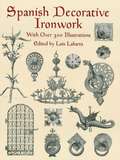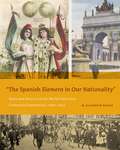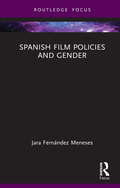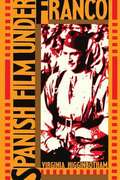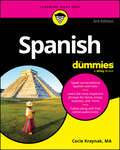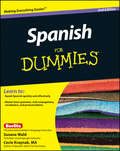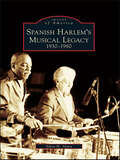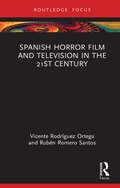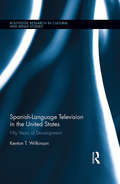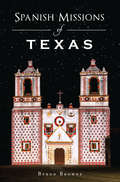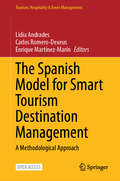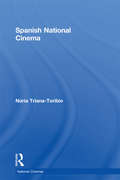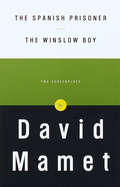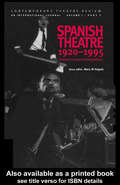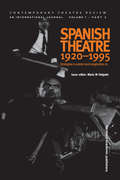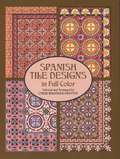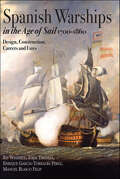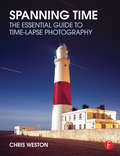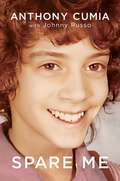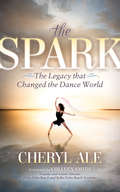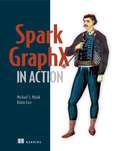- Table View
- List View
Spanish Decorative Ironwork
by Luis LabartaOver 300 outstanding illustrations -- thoughtfully selected and excellently reproduced -- depict ornate altar screens, doors, chandeliers, balcony railings, candelabra, tombstone crosses, pulpits, gates, window screens, and more. Brief captions identify the types, origins, and dates of pieces in this excellent collection for artists, interior designers, craftspeople, and lovers of antiques.
“The Spanish Element in Our Nationality”: Spain and America at the World’s Fairs and Centennial Celebrations, 1876–1915
by M. Elizabeth Boone"The Spanish Element in Our Nationality" delves beneath the traditional "English-only" narrative of U.S. history, using Spain’s participation in a series of international exhibitions to illuminate more fully the close and contested relationship between these two countries.Written histories invariably record the Spanish financing of Columbus’s historic voyage of 1492, but few consider Spain’s continuing influence on the development of U.S. national identity. In this book, M. Elizabeth Boone investigates the reasons for this problematic memory gap by chronicling a series of Spanish displays at international fairs. Studying the exhibition of paintings, the construction of ephemeral architectural space, and other manifestations of visual culture, Boone examines how Spain sought to position itself as a contributor to U.S. national identity, and how the United States—in comparison to other nations in North and South America—subverted and ignored Spain’s messages, making it possible to marginalize and ultimately obscure Spain’s relevance to the history of the United States.Bringing attention to the rich and understudied history of Spanish artistic production in the United States, "The Spanish Element in Our Nationality" recovers the "Spanishness" of U.S. national identity and explores the means by which Americans from Santiago to San Diego used exhibitions of Spanish art and history to mold their own modern self-image.
The Spanish Element in Our Nationality”: Spain and America at the World’s Fairs and Centennial Celebrations, 1876–1915
by M. Elizabeth Boone“The Spanish Element in Our Nationality” delves beneath the traditional “English-only” narrative of U.S. history, using Spain’s participation in a series of international exhibitions to illuminate more fully the close and contested relationship between these two countries.Written histories invariably record the Spanish financing of Columbus’s historic voyage of 1492, but few consider Spain’s continuing influence on the development of U.S. national identity. In this book, M. Elizabeth Boone investigates the reasons for this problematic memory gap by chronicling a series of Spanish displays at international fairs. Studying the exhibition of paintings, the construction of ephemeral architectural space, and other manifestations of visual culture, Boone examines how Spain sought to position itself as a contributor to U.S. national identity, and how the United States—in comparison to other nations in North and South America—subverted and ignored Spain’s messages, making it possible to marginalize and ultimately obscure Spain’s relevance to the history of the United States.Bringing attention to the rich and understudied history of Spanish artistic production in the United States, “The Spanish Element in Our Nationality” recovers the “Spanishness” of U.S. national identity and explores the means by which Americans from Santiago to San Diego used exhibitions of Spanish art and history to mold their own modern self-image.
Spanish Film Policies and Gender (Routledge Focus on Media and Cultural Studies)
by Jara Fernández MenesesThis book provides a comprehensive cultural and historical account of the key film policies put into place by the Spanish state between 1980 and 2010 through a gendered lens, framing these policies within the wider context of European film legislation.Departing from the belief that there is no such thing as an objective and value-neutral approach to policy analysis because our society is organised around gender, this volume builds upon Pierre Bourdieu’s theory of field to propose that film policies do not emerge in a vacuum because they respond to different demands from those agents involved in the field of the Spanish cinema. By so doing, it critically assesses how these policies have come into being, by whom, in response to what interests, how they have shaped the Spanish film industry, and how far and in what ways they have tackled gender inequality in the Spanish film industry.This book will be of great interest to scholars and students of Spanish cinema, gender studies, film industry studies, film policy, and feminist film studies.
Spanish Film under Franco
by Virginia HigginbothamHow does a totalitarian government influence the arts, and how do the arts respond? Spanish Film Under Franco raises these important questions, giving English speakers a starting point in their study of Spanish cinema. After a brief overview of Spanish film before Franco, the author proceeds to a discussion of censorship as practiced by the Franco regime. The response of directors to censorship-the "franquista aesthetic," or "aesthetic of repression," with its highly metaphorical, oblique style-is explored in the works of Luis Buñuel, Carlos Saura, Juan Antonio Bardem, Luis García Berlanga, and other important directors. Virginia Higginbotham combines historical perspective with detailed critical analysis and interpretation of many famous Franco-era films. She shows how directors managed to evade the censors and raise public awareness of issuesrelating to the Spanish Civil War and the repressions of the Franco regime. Film has always performed an educational function in Spain, reaching masses of poor and uneducated citizens. And sometimes, as this study also reveals, Spanish film has been ignored when the questions it raised became too painful or demanding. The author concludes with a look at post-Franco cinema and the directions it has taken. For anyone interested in modern Spanish film, this book will be essential reading.
Spanish For Dummies
by Cecie KraynakLearn to speak Latin American Spanish with confidence—the easy way Spanish For Dummies gets you started with the Spanish language, even if you've never learned a language before. The trusted Dummies language learning method is quick and practical, so you'll know what to say and do when traveling to a Spanish-speaking country or interacting with Spanish speakers in your community. You'll learn the basics of Spanish grammar and pronunciation, and then you'll explore common phrases you'll need in everyday situations. Get ready to study, work, or travel abroad—or integrate Spanish into your everyday life. This essential resource helps you make small talk, understand common expressions, navigate business settings, ask for directions, go to the doctor, and beyond. Learn how Latin American Spanish works—grammar, pronunciation, and important constructions Build your vocabulary and learn common expressions you'll hear while abroad Brush up your conversation skills with authentic dialogues, plus follow along with online audio Get practice reading, writing, and speaking Spanish, so you're ready to communicate effectively With Spanish For Dummies, students, travelers, and business professionals can gain the confidence to converse in Spanish.
Spanish For Dummies
by Susana Wald Cecie KraynakLearn Latin American Spanish quickly and painlessly The job market for those who are bilingual is expanding rapidly. Businesses and government agencies are hiring translators; retailers and advertisers are concentrating more energy in targeting the Spanish-speaking ; and hospitals and agencies are seeking to overcome language barriers. Whether you’re a student studying Spanish, a traveler gearing up for a trip to a Spanish-speaking country and need to learn the basics, or a upwardly mobile looking to get ahead of the pack in your career by learning a second language, Spanish For Dummies, 2nd edition is your hands-on guide to quickly and painlessly learn Latin American Spanish that includes: Expanded coverage of grammar, verb conjugations, and pronunciations A refreshed and expanded mini-dictionary complete with even more essential vocabulary, exercises, and more A revamped and expanded bonus CD-ROM that includes real-life dialogue to aid in your learning Whether you’re looking to learn Spanish for use in the home, class, at the office, or on the go, Spanish For Dummies, 2nd edition has you covered!
Spanish Harlem's Musical Legacy: 1930-1980
by Silvio H. AlavaSpanish Harlem�s musical development thrived between the 1930s and 1980s in New York City. This area was called El Barrio by its inhabitants and Spanish Harlem by all others. It was a neighborhood where musicians from the Caribbean or their descendants organized musical groups, thereby adding to the diaspora that began in Africa and Spain. The music now called salsa had its roots in Cuba, Puerto Rico, and Santo Domingo, and it continued developing onanother island: Manhattan.
Spanish Horror Film and Television in the 21st Century (Routledge Focus on Media and Cultural Studies)
by Vicente Rodríguez Ortega Rubén Romero SantosThis book provides an up-to-date, in-depth survey of 21st-century Spanish horror film and media, exploring both aesthetics and industrial dynamics. It offers detailed analysis of contemporary films and TV series as well as novel approaches to key works within the history of Spanish cinema. While addressing the specificities of the Spanish landscape, this volume also situates the national cinematic output within the international arena, understanding film production and reception as continuously changing processes in which a variety of economic, social and cultural factors intervene. The book first analyzes the main horror trends emerging in the early 2000s, then approaches genre hybridization and the rise of new filmmakers since the 2010s with a special focus on gender issues and the reconfiguration of the past, before addressing the impact of streaming services within the Spanish film panorama, from a production and distribution standpoint. This book will be of keen interest to scholars and students in the areas of film studies, media studies, TV studies, horror, Spanish cultural studies and production studies.
Spanish-Language Television in the United States: Fifty Years of Development (Routledge Research in Cultural and Media Studies)
by Kenton T. WilkinsonSince its introduction in the early 1960s, Spanish-language television in the United States has grown in step with the Hispanic population. Industry and demographic projections forecast rising influence through the 21st century. This book traces U.S. Spanish-language television’s development from the 1960s to 2013, illustrating how business, regulation, politics, demographics and technological change have interwoven during a half century of remarkable change for electronic media. Spanish-language media play key social, political and economic roles in U.S. society, connecting many Hispanics to their cultures of origin, each other, and broader U.S. society. Yet despite the population’s increasing impact on U.S. culture, in elections and through an estimated $1.3 trillion in spending power in 2014, this is the first comprehensive academic source dedicated to the medium and its history. The book combines information drawn from the business press and trade journals with industry reports and academic research to provide a balanced perspective on the origins, maturation and accelerated growth of a significant ethnic-oriented medium.
Spanish Lessons: Cinema and Television in Contemporary Spain
by Paul Julian SmithThough unjustly neglected by English-language audiences, Spanish film and television not only represent a remarkably influential and vibrant cultural industry; they are also a fertile site of innovation in the production of "transmedia" works that bridge narrative forms. In Spanish Lessons, Paul Julian Smith provides an engaging exploration of visual culture in an era of collapsing genre boundaries, accelerating technological change, and political-economic tumult. Whether generating new insights into the work of key figures like Pedro Almodóvar, comparing media depictions of Spain's economic woes, or giving long-overdue critical attention to quality television series, Smith's book is a consistently lively and accessible cultural investigation.
Spanish Missions of Texas (Landmarks)
by Byron BrowneAfter the conquest of Mexico by Hernán Cortés in the sixteenth century, conquistadors and explorers poured into the territory of Nueva España. The Franciscans followed in their wake but carved a different path through a harsh and often violent landscape. That heritage can still be found across Texas, behind weathered stone ruins and in the pews of ornate, immaculately maintained naves. From early structures in El Paso to later woodland sanctuaries in East Texas, these missions anchored communities and, in many cases, still serve them today. Author Byron Browne reconnoiters these iconic landmarks and their lasting legacy.
The Spanish Model for Smart Tourism Destination Management: A Methodological Approach (Tourism, Hospitality & Event Management)
by Lidia Andrades Carlos Romero-Dexeus Enrique Martínez-MarínThis is an open access handbook that guides destinations on their journey to becoming Smart Tourism Destinations (STDs). Developed by SEGITTUR, a distinguished Spanish State company, and aligned with academia represented by Professor Lidia Andrades, who has brought together recognized international academics with SEGITTUR experts in the field of tourism management to write this groundbreaking book, it offers practical insights and strategies for success. Explore the characteristics and implications of smart destinations, across the five dimensions which structure them: destination governance, accessibility, technology, innovation and sustainability, navigate the transition from traditional tourism management to the innovative smart managerial paradigm, and overcome challenges encountered during the transformative process. Equipping destination managers with essential tools and strategies, this handbook showcases real-life examples of Spanish destinations embracing the smart tourism paradigm. Drawing on SEGITTUR's proven methodology, it provides precise guidance, checklists, and expert recommendations for effective implementation. An invaluable resource for destination managers, tourism professionals, and researchers, it unlocks the full potential of smart tourism destinations.
Spanish National Cinema (National Cinemas)
by Nuria Triana-ToribioThis study examines the discourses of nationalism as they intersected or clashed with Spanish film production from its inception to the present. While the book addresses the discourses around filmmakers such as Almodóvar and Medem, whose work has achieved international recognition, Spanish National Cinema is particularly novel in its treatment of a whole range of popular cinema rarely touched on in studies of Spanish cinema. Using accounts of films, popular film magazines and documents not readily available to an English-speaking audience, as well as case studies focusing on the key issues of each epoch, this volume illuminates the complex and changing relationship between cinema and Spanish national identity.
The Spanish Presence in Sixteenth-Century Italy: Images of Iberia (Transculturalisms, 1400-1700)
by Piers Baker-Bates Miles PattendenThe sixteenth century was a critical period both for Spain’s formation and for the imperial dominance of her Crown. Spanish monarchs ruled far and wide, spreading agents and culture across Europe and the wider world. Yet in Italy they encountered another culture whose achievements were even prouder and whose aspirations often even grander than their own. Italians, the nominally subaltern group, did not readily accept Spanish dominance and exercised considerable agency over how imperial Spanish identity developed within their borders. In the end Italians’ views sometimes even shaped how their Spanish colonizers eventually came to see themselves. The essays collected here evaluate the broad range of contexts in which Spaniards were present in early modern Italy. They consider diplomacy, sanctity, art, politics and even popular verse. Each essay excavates how Italians who came into contact with the Spanish crown’s power perceived and interacted with the wider range of identities brought amongst them by its servants and subjects. Together they demonstrate what influenced and what determined Italians’ responses to Spain; they show Spanish Italy in its full transcultural glory and how its inhabitants projected its culture - throughout the sixteenth century and beyond.
The Spanish Prisoner and The Winslow Boy: Two Screenplays
by David MametTHE SPANISH PRISONER "Elegant, entertaining. . . . Mamet's craftiest and most satisfying cinematic puzzle. " --The New York Times THE WINSLOW BOY "One of the most subtly compelling love stories of the year. " --The New York Observer Pulitzer Prize winner David Mamet ranks among the century's most influential writers for stage and screen. His dialogue--abrasive, rhythmic--illuminates a modern aesthetic evocative of Samuel Beckett. His plots--surprising, comic, topical--have evoked comparisons to masters from Alfred Hitchcock to Arthur Miller. Here are two screenplays demonstrating the astounding range of Mamet's talents. The Spanish Prisoner, a neo-noir thriller about a research-and-development cog hoodwinked out of his own brilliant discovery, demonstrates Mamet's incomparable use of character in a dizzying tale of twists and mistaken identity. The Winslow Boy, Mamet's revisitation of Terence Rattigan's classic 1946 play, tells of a thirteen-year-old boy accused of stealing a five-shilling postal order and the tug of war for truth that ensues between his middle-class family and the Royal Navy. Crackling with wit, intelligent and surprising,The Spanish PrisonerandThe Winslow Boycelebrate Mamet's unique genius and our eternal fascination with the extraordinary predicaments of the common man.
Spanish Theatre 1920-1995: Strategies in Protest and Imagination (1) (Contemporary Theatre Review Ser. #Vols. 7, Pts. 4)
by Maria M. DelgadoBeginning with a reassessment of the 1920s and 30s, this text looks beyond a consideration of just the most successful Spanish playwrights of the time, and discusses also the work of directors, theorists, actors and designers.
Spanish Theatre 1920 - 1995: Strategies in Protest and Imagination (2) (Contemporary Theatre Review Ser. #Vols. 7, Pts. 4)
by Maria M DelgadoBeginning with a reassessment of the 1920s and 30s, this text looks beyond a consideration of just the most successful Spanish playwrights of the time, and discusses also the work of directors, theorists, actors and designers.
Spanish Tile Designs in Full Color
by Carol Belanger GraftonSelected from rare l9th- and early-20th-century manufacturers' catalogs, the 97 full-color tile designs in this splendid collection display a host of patterns, many revealing striking Moorish influence. Predominantly blue, green, red, and brown with white backgrounds, the tiles incorporate stylized flowers, leaves, and other plant forms, abstract and geometric figures, stars, and suns.
Spanish Warships in the Age of Sail, 1700–1860: Design, Construction, Careers and Fates
by Rif Winfield John Tredrea Enrique García-Torralba Pérez Manuel Blasco Felip“A beautiful work . . . certain to become the standard work in English on the Spanish sailing navy.” —Seaways’ Ships in ScaleThis book is the latest contribution to a unique series in a common format documenting in great detail the warships of the major naval powers during the age of sail. To date, four volumes have covered the British Navy, two have been devoted to the French Navy and one each to the Dutch and Russian Navies. This volume on the Spanish Navy, for much of its history the third largest in the world, fills the final gap in the ranks of the major maritime powers. This book is the first comprehensive listing of these ships in English and covers the development of all the naval vessels owned or deployed by Spain during the period of the Bourbon monarchy from 1700 to 1860 (including the period of French control during the Napoleonic Wars), but it also sets the scene for that period by summarizing the origins of Spanish naval development under the preceding Habsburg regime. As with previous volumes in the series, the main chapters list all the naval vessels from 1700 onwards (including those 16th-century ships which survived into the new regime in 1700) by type, with the first chapters listing the ships of the line (navíos in Spanish terminology) and frigates in descending order of firepower, and subsequent chapters covering minor and ancillary vessels. Where available, a brief service history of each individual ship is given. Its publication is of the utmost importance to every naval historian and general reader interested in the navies of the sailing era.
Spanning Time: The Essential Guide to Time-lapse Photography
by Chris WestonSpanning Time: The Essential Guide to Time-lapse Photography is the ultimate how-to guide for creating time-lapse films, featuring both still and moving image techniques. Author Chris Weston provides all the information necessary to create compelling time-lapse sequences using a DSLR camera. As well as covering basic equipment requirements and shooting techniques, the book explores what makes a good time-lapse story, visualization, and advanced skills for creating multi-faceted time-lapse sequences. This book provides insider secrets including: How to create an effective time-lapse workflow and ‘see’ in a time-lapse sequence Tips and tricks to successful photographic elements such as shutter speed, aperture, exposure, ISO, dynamic range imaging, and more Step-by-step instructions for using the leading photographic processing hardware and software Best practices for overcoming challenges including time-lapse flicker, light conditions, and color temperatures
Spannungsfeld zwischen Fachkräftemangel und Wohnungsmangel: Mitarbeiterwohnungen als Lösungsansatz (Studien zum nachhaltigen Bauen und Wirtschaften)
by Thomas Glatte Mona BalkenholVor dem Hintergrund des aktuell herrschenden Wohnungsmangels und dem Mangel an Fachkräften in Deutschland werden Mitarbeiterwohnungen wieder neu entdeckt. Diese Publikation untersucht die Mitarbeiterwohnungen als passenden Lösungsansatz in dem Spannungsfeld zwischen Fachkräftemangel und Wohnungsmangel. Hierbei werden erste Einblicke in die Wahrnehmung von Akademikern der Generation Z in Bezug auf Mitarbeiterwohnungen gewährt. Ebenso stellt die Publikation Erkenntnisse für eine Steigerung der Arbeitgeberattraktivität gegenüber jungen Arbeitnehmern dar.
Spare Me
by Anthony CumiaYou won't want to miss the explosive insights and unfiltered perspective in legendary broadcaster Anthony Cumia&’s latest book.In his much-anticipated second book, Spare Me, radio personality and podcaster Anthony Cumia returns, unleashing a scorching and unapologetic commentary that spans the spectrum from politics to entertainment, while sparing no particular individual deserving of his legendary wrath.
The Spark: The Legacy that Changed the Dance World
by Cheryl AleThe Spark will help create a legacy dance students will never forget!The Spark: The Legacy that Changed the Dance World is about the journey of creative artists and dancers-turned-teachers who are now struggling with the complexities of teaching. Choosing a ballet program that juggles all styles, techniques, and methodologies and that all levels of students will progressively love is a daunting task. In this book, dance teachers will discover what the greatest masters have always known: the true essence of dancing. Quite simply, they will learn how to teach pure, fluid movement with an age-appropriate curriculum proven for the past 60 years to effectively transcend any limiting beliefs about the basis for all dance. If you’re looking for an empowered learning community with the perfect balance of discipline, integrity, and a curriculum that forms lifetime bonds with students, teachers, and parents, you’ve come to the right place. Celebrate your “sparkdom”!
Spark GraphX in Action
by Michael Malak Robin EastSummarySpark GraphX in Action starts out with an overview of Apache Spark and the GraphX graph processing API. This example-based tutorial then teaches you how to configure GraphX and how to use it interactively. Along the way, you'll collect practical techniques for enhancing applications and applying machine learning algorithms to graph data.Purchase of the print book includes a free eBook in PDF, Kindle, and ePub formats from Manning Publications.About the TechnologyGraphX is a powerful graph processing API for the Apache Spark analytics engine that lets you draw insights from large datasets. GraphX gives you unprecedented speed and capacity for running massively parallel and machine learning algorithms.About the BookSpark GraphX in Action begins with the big picture of what graphs can be used for. This example-based tutorial teaches you how to use GraphX interactively. You'll start with a crystal-clear introduction to building big data graphs from regular data, and then explore the problems and possibilities of implementing graph algorithms and architecting graph processing pipelines. Along the way, you'll collect practical techniques for enhancing applications and applying machine learning algorithms to graph data.What's InsideUnderstanding graph technologyUsing the GraphX APIDeveloping algorithms for big graphsMachine learning with graphsGraph visualizationAbout the ReaderReaders should be comfortable writing code. Experience with Apache Spark and Scala is not required.About the AuthorsMichael Malak has worked on Spark applications for Fortune 500 companies since early 2013. Robin East has worked as a consultant to large organizations for over 15 years and is a data scientist at Worldpay.Table of ContentsPART 1 SPARK AND GRAPHSTwo important technologies: Spark and graphsGraphX quick startSome fundamentalsPART 2 CONNECTING VERTICESGraphX BasicsBuilt-in algorithmsOther useful graph algorithmsMachine learningPART 3 OVER THE ARCThe missing algorithmsPerformance and monitoringOther languages and tools
